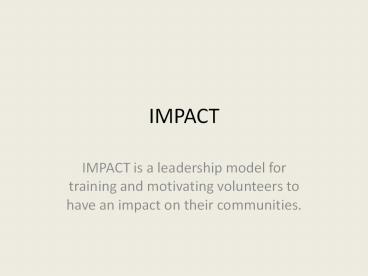IMPACT - PowerPoint PPT Presentation
1 / 14
Title: IMPACT
1
IMPACT
- IMPACT is a leadership model for training and
motivating volunteers to have an impact on their
communities.
2
Why Motivate and Train Volunteers?
- Source Volunteer Management Capacity in
Americas Charities and Congregations. The Urban
Institute 2004.
3
Why motivate and train volunteers?
- Major findings
- Devoting Substantial Staff Time Spent on
Volunteer - Management is a Best Practice. . . .
- The best prepared and most effective volunteer
programs are those with paid staff members who
dedicate a substantial portion of their time to
management of volunteers. This study demonstrated
that, as staff time spent on volunteer management
increased, adoption of volunteer management
practices increased as well. Moreover,
investments in volunteer Management and benefits
derived from volunteers feed on each other, with
investments bringing benefits and these benefits
justify greater investments.
4
Why motivate and train volunteers?
- Major findings
- However, Staff Time Spent in Volunteer
Management is Low. Three out of five charities
and only one out of three congregations with
social service outreach activities reported
having a paid staff person who worked on
volunteer coordination. However, among these paid
volunteer coordinators, one in three have not
received any training in volunteer management,
and half spend less than 30 percent of their time
on volunteer coordination. - Most Volunteer Management Practices Have Not
Been Adopted to a Large Degree. Less than half of
charities and congregations that manage
volunteers have adopted most volunteer management
practices advocated by the field. For example,
only about one-third of charities say they have
adopted to a large degree the practice of
formally recognizing the efforts of their
volunteers.
5
Why Impact the Community?
- Source Tom Ralser. ROI for Nonprofits The New
Key to Sustainability. John Wiley and Sons
2007. - Must move from measuring outputs to measuring
outcomes. - An organization must create outcomes that
volunteers and contributors value.
6
Why Impact the Community?
- Outputs The tangible results of a process or
program. - Examples Number of people who attended event or
classes. Number of given, etc. - Outcomes The impact that a group desires to have
on the people being served. - Examples Specific changes in the behaviors of
event attendees, class participants.
7
Why Impact the Community?
- Many churches still make output goals. These are
intermediate or process goals. They are not
final goals. - Every church needs to create and improve outcome
goals development and implement activities to
create higher impact activities.
8
Identify
- Luke 14.28-32
- Current Impact of Activities.
- Current Asset use to perform that activities.
- Current skill level in executing activities.
- Dominant group values and individual values.
9
Motivate
- Align Values.
- Seek Volunteer Input.
- Create Overall Impact Targets.
- Develop Urgency to promote change.
10
Plan
- Create short, intermediate, long-term impact
targets. - Impact targets require a concrete action verb.
Ex. participate vs. desire. (See Blooms
taxonomy). - Specific actions to accomplish activities.
- Determine key skills.
- Determine implementation strategy.
- Create volunteer skills development plan.
- Create volunteer appreciation strategy.
11
Act
- Implement the plan that you have made.
- Coach volunteers as they do their tasks.
- Watch for specific problems and opportunities.
- Provide ongoing feedback.
- Make week adjustments.
12
Consider
- Creating evaluation criteria.
- Determine evaluation audience.
- Summarize ongoing evaluations.
- Conduct intermediate, point-in-time evaluations.
- Strategic evaluations.
13
Transform
- Use evaluations to learn how to increase
volunteer skill and satisfaction, activity
impacts.
14
Results
- More focused mission.
- Greater community impact.
- Increased group participation, moral and skills.































